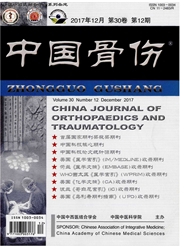

 中文摘要:
中文摘要:
目的:通过实验进一步探讨局部应用神经生长因子的途径和方法。方法:24只SD大鼠共分为实验组和对照组(每组12只)。腹腔麻醉后,俯卧位切开胸椎椎板。用微量注射器,分别对其进行经DOTAP转染的含报告基因质粒(实验组)和空载体-脂质体粒(对照组)的鞘内直接注射。术后2周处死动物,取相应节段脊髓组织行RT-PCR及免疫组化检测。结果:免疫组化发现,在实验组脊髓组织胶质细胞及神经元中可见beta-半乳糖苷酶阳性染色。同样,在相同组织RT-PCR检测到Lac Z mRNA。而对照组无上述阳性发现。结论:外源性基因于体内神经组织中有效转染是目前治疗脊髓损伤的热点。通过上述技术将特定神经生长因子输入局部损伤区域,有助于促进中枢神经再生,避免早期继发损伤。
 英文摘要:
英文摘要:
Objective:To explore a way of the gene therapy for acute spinal cord injury (ASCI) by vivo transfection of exogenous gene into spinal cord tissue. Methods:Twenty-four rats of SD were divided into experiment group and control group (each group had 12 rats). After anaesthesia by abdominal cavity,lamina of thoracic vertebra of all rats were cut-open in prone position. Complex of plasmid and report gene-Lac Z,and plasmid without report gene-Lac Z were respectively injected into cavum subdural of SD rats of experiment group and control group by cation liposome (DOTAP) encapsulation. The rats were killed at the 2nd week after operation,spinal cord tissue of injected segments were detected by reverse transcription-polymerase chain raction (RT-PCR) and immunohistochemistry. Results:In experiment group,positive staining of β-galactosidase can be clearly observed in neuron and glia cell of rat's spinal cord by immunohistochemistry detection. Lac Z mRNA in same area was also detected by RT-PCR. But,in control group,no above-mentioned positive results were found. Conclusion:Effective transfection of exogenous gene in vivo into spinal cord is a new hot spot for treatment of SCI. Thus certain nerve growth factor imput partly area of spinal cord injury can promote central nerve regrowth and avoid early secondary injury.
 同期刊论文项目
同期刊论文项目
 同项目期刊论文
同项目期刊论文
 期刊信息
期刊信息
